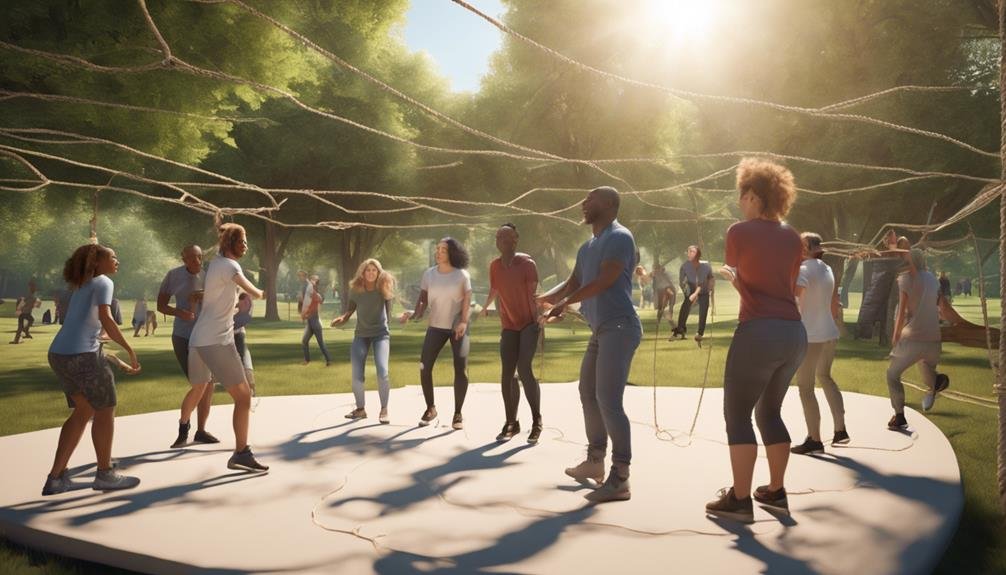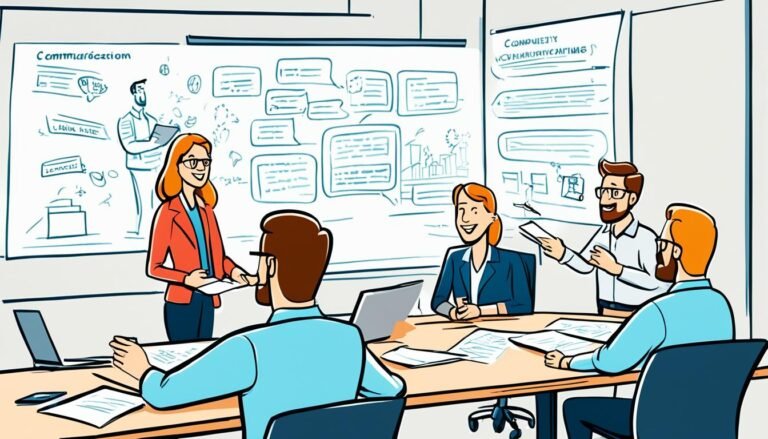Team Building as a Soft Skill
Master team building as a soft skill to strengthen relationships, boost collaboration, and improve team performance. Understand its significance, unite individual skills for common goals, and foster a positive work culture. Effective team building involves clear objectives, tailored activities, open communication, and feedback mechanisms. Strong team dynamics enhance productivity, promote unity, and facilitate goal achievement. Strategies like trust exercises, transparent communication, and resolving conflicts constructively are key. Developing communication skills, fostering collaboration, and engaging in team-building activities further enhance teamwork. Embrace team building for a more cohesive and successful team environment.
Key Takeaways
- Team building enhances communication, collaboration, and trust among team members.
- It fosters soft skills like active listening, empathy, and conflict resolution.
- Building strong teams cultivates a positive work culture and boosts productivity.
- Soft skills acquired through team building are essential for effective teamwork.
- Team building activities promote problem-solving, creativity, and adaptability in a team setting.
The Importance of Team Building
Understanding the significance of team building is essential for fostering a collaborative and successful work environment. Building collaborative relationships within a team is critical for achieving effective teamwork. When team members work together cohesively, they can combine their individual skills and experiences to achieve common goals more efficiently. Team building activities provide opportunities for team members to bond, communicate, and trust each other, leading to improved collaboration.
Effective teamwork isn't only about individuals working towards a shared objective but also about creating a supportive environment where team members feel valued and respected. Team building helps in breaking down barriers and enhancing communication among team members, which is crucial for successful collaboration. By participating in team building exercises, individuals can learn to appreciate each other's strengths and weaknesses, leading to a more cohesive and productive team. Ultimately, team building plays a fundamental role in fostering a positive work culture and enhancing overall team performance.
Elements of Effective Team Building
To create effective team building experiences, incorporating diverse activities that cater to different team members' strengths and preferences is crucial. By utilizing various team building techniques, you can enhance group cohesion and foster a more productive work environment. Here are four key elements to contemplate when planning team building activities:
- Clear Objectives: Define specific goals for the team building session to make certain that everyone understands the purpose and expected outcomes.
- Inclusivity: Tailor activities to accommodate different personalities and working styles within the team to promote inclusivity and participation.
- Effective Communication: Encourage open communication among team members to strengthen relationships and promote collaboration.
- Feedback Mechanisms: Implement feedback mechanisms to gather insights on the team building activities and continuously improve future initiatives.
Benefits of Strong Team Dynamics
Strengthening team dynamics through effective communication and collaboration cultivates a harmonious work environment conducive to enhanced productivity and morale. Positive relationships within a team are essential for fostering a sense of unity, trust, and respect among team members. When team members have strong relationships, they're more likely to communicate openly, support each other, and work towards common goals collaboratively.
Team success is greatly influenced by the dynamics within the team. A team that functions well together is better equipped to tackle challenges, adapt to changes, and achieve objectives efficiently. Strong team dynamics also contribute to a positive work culture where team members feel motivated, valued, and engaged in their work.
Furthermore, when team dynamics are robust, individuals are more likely to share knowledge, skills, and experiences, leading to continuous learning and improvement. This sharing of expertise enhances the overall competence of the team and boosts its potential for success. Essentially, investing in building strong team dynamics is crucial for achieving both individual and collective accomplishments.
Strategies for Building Trust
Building trust within a team starts with fostering open and honest communication among team members. This pivotal foundation is essential for effective collaboration and a positive team dynamic.
To enhance trust and strengthen relationships within your team, consider the following strategies:
- Trust Exercises: Engage in activities that require team members to rely on each other, fostering a sense of trust and interdependence.
- Relationship Building: Encourage team members to get to know each other on a personal level to build rapport and strengthen bonds.
- Transparency: Be open and transparent in your communication to establish credibility and trust among team members.
- Consistency: Demonstrate reliability and consistency in your actions and decisions to build trust over time.
Enhancing Communication Skills
Enhance your team's communication skills by fostering a culture of active listening and clear articulation. Listening skills are essential in effective communication. Encourage your team members to listen attentively, without interrupting, and to ask clarifying questions to guarantee understanding. By actively listening, individuals demonstrate respect and empathy towards their colleagues, which in turn fosters stronger relationships and collaboration within the team.
Empathy building is another vital aspect of enhancing communication skills. Encouraging team members to put themselves in others' shoes helps create a more understanding and supportive work environment. Empathy allows individuals to connect on a deeper level, leading to improved communication and problem-solving.
Clear articulation is equally important. Encourage your team to express their thoughts and ideas in a concise and coherent manner. Emphasize the importance of clarity to avoid misunderstandings and promote effective communication within the team.
Resolving Conflict Constructively
Improving conflict resolution skills within your team is essential for maintaining a productive and harmonious work environment. Conflict resolution is a critical aspect of team cohesion, and mastering this skill can lead to stronger relationships and more effective collaboration.
Here are four key strategies to help you resolve conflicts constructively:
- Active Listening: When conflicts arise, take the time to listen attentively to all parties involved. Understanding each person's perspective is vital for finding common ground.
- Open Communication: Encourage team members to express their thoughts and feelings openly and respectfully. Clear communication can help prevent misunderstandings that often lead to conflicts.
- Seeking Compromise: Instead of focusing on winning the argument, aim to find solutions that benefit everyone involved. Compromise is essential to maintaining a positive team dynamic.
- Mediation or Facilitation: In cases where conflicts escalate, consider involving a neutral third party to help mediate the situation. An impartial mediator can guide the discussion towards a resolution that satisfies all parties.
Fostering Collaboration and Innovation
To foster a culture of collaboration and innovation within your team, consider implementing strategies that encourage creativity and collective problem-solving. Collaboration techniques such as brainstorming sessions, group discussions, and cross-functional teams can help generate new ideas and perspectives. Encouraging open communication and active listening among team members fosters a supportive environment where innovative thinking thrives.
Incorporating diverse viewpoints and skill sets can lead to more creative solutions to complex problems. By creating opportunities for team members to share their thoughts and experiences, you can harness the power of collaboration to drive innovation. Providing training on effective collaboration techniques and fostering a culture that values experimentation and learning from failures can further enhance your team's innovative capabilities.
Team Building Activities and Exercises
Wondering what team building activities and exercises can strengthen your team's cohesion and collaboration? Engaging in well-thought-out activities can greatly boost teamwork and morale. Here are four effective ways to enhance your team's dynamics:
- Outdoor Retreats: Take your team out of the office environment and into nature. Outdoor retreats offer an invigorating change of scenery and encourage bonding through shared experiences like camping, hiking, or team-building challenges.
- Problem-Solving Games: Encourage critical thinking and collaboration with problem-solving games. These activities challenge your team to work together, communicate effectively, and think creatively to overcome obstacles.
- Escape Room Challenges: Escape rooms provide a fun and interactive way for teams to collaborate under pressure. By solving puzzles and riddles within a time limit, team members learn to leverage each other's strengths and communicate efficiently.
- Team Sports: Engaging in team sports promotes camaraderie and healthy competition. Whether it's a friendly game of volleyball or basketball, sports activities foster teamwork, communication, and trust among team members.
Conclusion
To sum up, team building is an important soft skill that can greatly benefit any organization. By fostering strong team dynamics, trust, communication, and collaboration, teams can work together more effectively and achieve better results.
Remember, a team is like a well-oiled machine – each part must work together seamlessly to achieve success. So, invest in team building activities and exercises to make sure your team is operating at its full potential.








